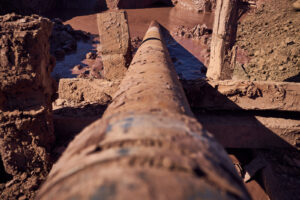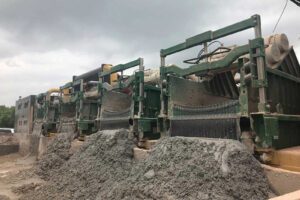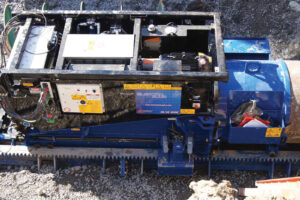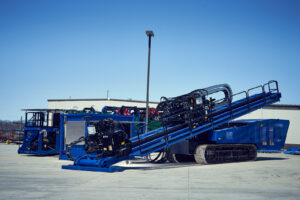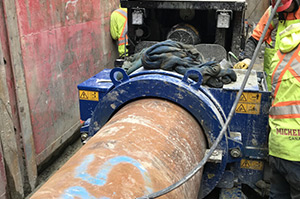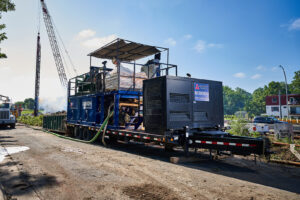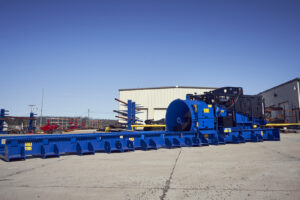Horizontal directional drilling — better known as HDD — is now 50 years old. Hard to believe there was a time that such an integral component of the arsenal of trenchless tools was unheard of or not commonly used.
Martin Cherrington — commonly referenced as the Father of HDD — crossed the Pajaro River in northern California in 1971 using HDD without much fanfare. In fact, he didn’t think much of his accomplishment at the time. Looking back on this milestone anniversary, he simply says, “Time flies when you’re having fun!”
Looking back on this innovative and game-changing construction application, it has been a fun and wild ride. The ride has had starts and stops and we are on a steady and strong path in 2021, with HDD widely accepted as a first option for infrastructure installation.
Once unknown or met with skepticism, HDD today is a multi-billion-dollar, global industry — that continues to grow with each year. HDD encompasses more than just underground infrastructure, including manufacturing, contracting, engineering, and educational sectors, as well. HDD is used to install natural gas, water, wastewater, electric, telecommunication and fiber-optic lines every day across North America and around the world. Once unique to see a directional drill working in your neighborhood, they are now routinely seen drilling in neighborhoods everywhere, leaving behind minimal social, environmental and restorative impacts.
“The adoption of HDD is widespread in a number of industries and being used for things we never dreamed of when we began,” says Richard Levings, longtime industry professional and product manager at Ditch Witch and American Augers. “It’s the largest percentage of any underground installation method. HDD is used more than any other method. Globally it’s a multi-billion-dollar industry, not just in rig sales but in the amount of work that contractors do and the amount of money that HDD saves owners who are installing the networks.”
The last 50 years has accumulated so many industry pioneers who have left their mark. Besides Cherrington — who is still active and innovating the industry he created at age 84 — names such as John Mercer, Richard Melsheimer, Gary Vermeer, Ed Malzahn, Pete Tynes, Frank Canon, John Hair, Ron Haldeman, and Hugh O’Donnell, come to mind, along with many, many others. Each has left their indelible marks on HDD through engineering, manufacturing or contracting.
HDD started off slowly, coming into prominence in the mid-1990s as the telecom/fiber-optic boom propelled HDD into the construction lexicon. New technologies came in rapid fire succession. Construction brands Vermeer, Ditch Witch, and American Augers led the way in rig technology, followed by many others, with a back and forth in upgrades and improvements. Tooling, locating and steering systems, drill pipe and drilling fluid technology all vastly improved at the same time.
In the classrooms and labs, HDD research and education ramped up at the university levels. Design engineers, once slow to adopt the method, began integrating the application in project specifications as acceptance took hold.
“[HDD] is most definitely a maturing industry but it is in no way mature,” says Vermeer Industrial Solutions president Doug Hundt, who has been in the industry for 25 years, coming in as HDD just started taking off. “[The market] grew exponentially during those years, about 20 to 50 percent each year. It went from being a novelty and by 2000 when the dot com boom was happening, there were thousands of rigs being produced every year.”
The industry started off with shorter lengths and smaller diameters. Today, installation bores are routinely in the thousands of feet, with product diameters upward to 48 in. Intersect HDD applications gave project designers and drillers the capability to more than double the length of projects. One recent intersect bore exceeded 17,000 ft in Hong Kong!
“In the early days, the knowledge wasn’t there, the tools weren’t there, the experience wasn’t there and, quite frankly, there wasn’t a lot of trust with the engineers who were designing the infrastructure and that’s where it has to start. They have to specify and design the job to be done with a different method,” Levings says.
As the Story Goes
Those who live and breathe HDD are familiar with the industry’s origins. For those newcomers, here’s how it got its start.
In 1971, Martin Cherrington was in Watsonville, California, drilling gas lines for Pacific Gas & Electric (PG&E). While in town, PG&E asked him to take a look at a small problem the utility was facing: how to drill about 500 ft across the Pajaro River to install a 4-in. gas line. Could he drill underneath the river instead of using the more disruptive and costly open-cut method?
Cherrington said the query intrigued him, because at that time nobody had ever attempted that kind of crossing. Initially, he and his Titan Contractors’ crew tried to make the crossing using conventional oil field drilling tools. That was a no go and back to the drawing board. This time, he used discarded road boring tools that had a defect to its bottom hole assembly, resulting in the tooling coming up in the middle of roadway. “And that’s how we finished the job,” Cherrington relates. “We aimed down [into the soil]. There was very little water in the river at the time. First thing that it did was pop up early in the river bottom. We dug a big hole around that exit point, bent the pipe down and pushed it back down into the ground and drilled a little further until it popped up again. We did that three times until we crossed to the other side.”
The first crude HDD crossing had been completed about a month after it started. But it made an impression on those who learned about it. An industry was born.
Cherrington’s work sparked interest in longer crossings involving pipeline work. Another market came to life during the 1980s that involved shorter, utility installations to replace buried power and cable lines (these lines were installed in the 1960s as part of Lady Bird Johnson’s Beautify America program, which among the initiatives, had power and cable lines installed underground vs. overhead).
John Mercer — founder of Digital Control Inc. (DCI) in the mid-1990s — worked for Flow Mole during this important period. The company was researching a way to replace these power and cable lines in areas where easements weren’t accessible, and a small footprint was critical. Mercer and Flow Mole created the Guide Drill, a small drill with 1,600 lbs of thrust that used 1-in. drill pipe that could be taken into neighborhoods to install the lines; a cable locator was used to track the underground pipe.
“Our Guide Drill had only 1,600 lbs of thrust, which is laughable these days, and had to be used in softer soils,” Mercer says.
Mercer left Flow Mole in 1988, creating his own company with partner Peter Hambling. Together they developed DCI into the industry’s premier locating system manufacturer and designer.
From there, HDD began its slow build to where it is today. The first big nudge came in the early 1990s with gas projects in the Midwest. Established construction manufacturers Ditch Witch and Vermeer stepped into the industry in late 1980s/early 1990s, designing rigs at a record pace as the telecom and fiber-to-the-home boom took off. From there, bigger and better things were ahead.
Cherrington’s firsrt HDD rig was built for a river crossing, shown here working on a series of river crossing projects in the 1970s.
Research and Education
Research and education are critical to the growth of any industry. HDD is no different. In the early days, both were lacking. When HDD was getting off the ground, Dr. Sam Ariaratnam was a civil engineering faculty member at the University of Alberta in Canada. In 1996 he was first introduced to HDD by a contractor. Twenty-five years later, Ariaratnam remains at the forefront of HDD education, training and research. He joined Arizona State University in 2001, tasked with building its underground utility construction program. He’s led the charge to bring the next generation of HDD professionals into the industry, as well as training current HDD professionals.
“Today, we have former graduate students who have become professors who know about HDD and they help impart the word to their students,” he says. “It’s still the early days of research and it’s a relatively blank canvas in terms of there is so much that can be done for HDD. There’s a lot [of research] that has been done for HDD and many more things we need to continue to do to keep advancing the engineering aspect of HDD.”
Across North America there are student trenchless chapters, exposing the industry to this next generation, and incorporating HDD coursework into engineering and construction programs. The engineering students of 10 to 15 years ago are now leading the way and are HDD veterans.
Ariaratnam notes that education doesn’t stop at the university level. Today’s HDD professionals seek out comprehensive training courses to increase their knowledge. Courses such as the annual HDD Academy — developed and organized by Benjamin Media Inc. and Ariaratnam — as well as the NASTT HDD Good Practices Guidelines course, provide that needed knowledge. “There is an appetite for formal HDD education,” he says. “People come from all over the world to get an education in HDD.”
Having engineers already familiar with and comfortable in designing HDD is a huge facet of the industry’s growth. That wasn’t always the case as the engineering community is a relatively conservative bunch, not willing to jump into new design methods for million-dollar projects without precedent and data that it will be successful, says Bennett Trenchless founder Dr. David Bennett, who was first introduced to HDD in 1991 when he was with the U.S. Army Corps of Engineers and met Dr. Tom Iseley. Iseley proposed that USACE work with him and Louisiana Tech University’s Trenchless Technology Center to establish a rehabilitation test facility at Louisiana Tech. Bennett proposed expanding the idea to build large-scale field test facilities for new installation techniques and technologies.
“[Engineers] were slower to come around to HDD than the contractors and manufacturers,” Bennett says. “We like to investigate and make sure the claims that are being made are reasonable and that owners and regulatory agencies aren’t going to suffer because of overpromising and underdelivering by the industry.”
One of the concerns of engineers, as well as regulatory/permitting agencies, involved the possibility of hydrofractures that could lead to adverse environmental consequences. “There weren’t any design guidelines or practices to follow,” Bennett remembers. “Engineers had very little in the way of design precedence and didn’t really even know what the design elements were. In the early years, we didn’t have many previous successful projects to rely on for design practice. You had to be conservative and test hypotheses as you went.”
He says HDD engineering design practice began to mature in the mid-1990s as more HDD projects and more research projects were completed and reported in the literature. A big step was the development and publication of USACE HDD permitting guidelines, which Bennett and Kimberlie Staheli collaborated on with USACE headquarters staff in the 1990s. Design questions related to hydrofractures, installation loads, pipe stresses, and other concerns were addressed, even if the methods were still a bit crude and field data needed to confirm and refine methods were scarce. Engineers and researchers have now tested theories and calibrated the results against case history observations to a greater extent. Design and construction practice has evolved, partly because we have learned from our mistakes.
In 2001, Bennett and Ariaratnam, with support from NASTT and the industry, collaborated with numerous HDD pioneers from manufacturing, contracting, and suppliers, to write and publish the HDD Good Practices Guidelines, an HDD industry collaborative handbook still in use today. The first edition focused on construction good practices and competent person responsibilities. The Guidelines evolved over the years to include design good practices, and are now in its fourth edition. The Guidelines have been translated into multiple languages, and brought to light, in an objective way, the various aspects of HDD.
“There has been a lot of trial and error and unfortunately, a lot of errors in the trials,” Bennett says. “That’s how an industry starts. The first generation of HDD practitioners were flying by the seat of their pants because they simply didn’t have the guidance or precedence and had to adapt lessons from oil field drilling, open-cut, and tunneling, etc. to what they were trying to accomplish with HDD. The second generation, which are working today, realized we had to improve design and construction practices and the industry did that.”
The third generation is here and making their mark,” Bennett says. “This third wave is much larger and smarter, and they’re going to make our accomplishments seem rather primitive and crude. They are building and expanding on a solid foundation that past generations established.”
Technological Advancements
HDD has come a long way in terms of technology. Better technology has made for a better and more efficient industry. The rigs went from using umbilical technology to being self-contained with rack-and-pinion carriages. Mechanized rod loading sped up the process and was safer, as it removed a person having to manually load the rods. HDD tooling improvements include fluted reamers and better, overall downhole tools.
Cherrington points to the electronic steering system in the late 1970s as the first big technological breakthrough as it gave drillers constant and real-time location of the drilling head. Prior to that the process was done manually using a single shot surveying tool that was also used in the oil patch. The system was slow and time-consuming. “[The electronic steering tool] would tell you where you were and it sped up things enormously,” he says.
Mercer notes how much more powerful the rigs are today vs. the early years and how the drill bits are “more aggressive and cut into the soil better.” He also notes that the locating systems are more accurate and user-friendly.
Levings says the most impactful advancements over the years have been mechanical, pointing to the rig technology such as the cutting head which went from a high-pressure water tooling to a slant-nose cutting device that allowed for faster and longer boring. He also points to the race between Ditch Witch and Vermeer to come out with newer and better technology. “Competition is healthy and keeps the industry moving forward,” Levings says. “The race between these two companies kept these advancements coming.”
“There were tremendous improvements in drillhead locating from where it started to where it is today,” Hundt says. “We’re able to locate deeper and get more reliable and accurate depth readings.”
Trenchless Technology publisher Bernie Krzys (left) with Martin Cherrington (center) and Grady Bell.
Impact of HDD
The impact of HDD is enormous and widespread. When you ask those in the industry, they don’t mince words about its importance today and in the future. The most common description: Game changer.
“It’s just huge,” Ariaratnam matter-of-factly says. “Not having to dig up roads and being able to cross bodies of water to install utilities? HDD has incredible environmental benefits.”
“For a modern economy, it’s absolutely critical to have infrastructure. HDD is the absolute centerpiece and critical technology to make modern infrastructure,” Hundt says. “If you think about if HDD hadn’t been invented, I don’t know if the world would have the same level of broadband capacity we have today. We wouldn’t have the same number of pipelines put in the ground. We wouldn’t have gas and electric pipes rehabbed to the same level of efficiency they have been. It’s an unspoken and unknown thing to a consumer but for those who build infrastructure, own infrastructure and implement improvements in infrastructure, it’s been a game-changer.”
“We’d have a disaster,” Mercer says if HDD had not been invented and open-cut continued to dominate. “All these streets would be torn up; traffic would be at a standstill just about everywhere. HDD is like magic in these areas.”
HDD for river crossings has advanced since the early years. Here, a rig is shown drilling underwater on a more recent job.
What’s Ahead
No one has the proverbial crystal ball to predict the future. But gauging on past and current trends regarding technology and HDD’s significance, it’s safe to say the application’s use is only going to get better, more widely used and more effective.
Does artificial intelligence (AI) have a place in HDD? Experts say yes and research & development have taken deep dives into trying to incorporate AI into HDD. No timetable has been spoken for when or if this will happen.
Operator expertise and equipment will be even more critical than it is today for future HDD projects. “You are going to see precision taken to another level,” says Levings. “Because unless they expand the easements you’re going to get to the point where there’s no room to work. Precision in working in those spaces will be even more important.”
Bennett says we will see a continuation of what we’ve seen in the industry, only with longer and larger diameter bores being drilled in more challenging conditions. “There will be improved design practices and construction methods to reduce risk and better meet the concerns of regulatory agencies,” he says. “I hope we continue to see improvements in pipe materials and in guidance and tracking, which have led to the ability to make these intersects and really long drilling projects possible.”
Continued growth around the world is also seen. In countries such as China, India, and Australia, HDD continues to grow while countries in Southeast Asia such The Philippines, Indonesia, Vietnam and Thailand are up and coming hot spots of HDD use, according to Ariaratnam, who has served as chairman of the International Society for Trenchless Technology (ISTT) and continues to travel the world for the industry.
“The global markets will continue to engage in HDD,” Ariaratnam says. “There are so many more opportunities for HDD around the world.”
And all of this started with one 500 ft crossing in 1971. No one has been more surprised than Cherrington over the globalization of HDD over the last 50 years. To him, that first HDD project was just another job he figured out how to complete.
“It’s a funny thing about that. When I finished that first job on the Pajaro River, I didn’t think that much about it,” Cherrington says. “To me it was just another job. It was a job we didn’t make any money on but apparently we made some friends along the way.”
And an industry was born.
